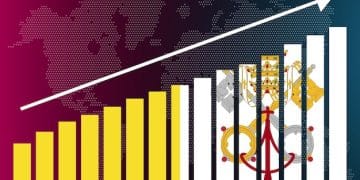Investing for Beginners: Building a Diversified Portfolio with $500

Investing for Beginners: A Practical Guide to Building a Diversified Portfolio with Just $500 offers a step-by-step approach for novice investors to create a diversified portfolio and achieve financial goals, even with limited initial capital and emphasizes the importance of understanding risk tolerance, diversification, and long-term investment strategies.
Embarking on your investment journey can feel daunting, especially with limited capital. Investing for Beginners: A Practical Guide to Building a Diversified Portfolio with Just $500 provides an accessible roadmap to start investing wisely, even on a tight budget. This guide will equip you with the knowledge and tools to build a diversified portfolio and begin working toward your financial goals.
Understanding the Basics of Investing
Before diving into the specifics of building a portfolio with $500, it’s crucial to grasp the fundamental concepts of investing. Understanding these basics will empower you to make informed decisions and navigate the investment landscape with confidence.
What is Investing?
At its core, investing involves allocating money with the expectation of generating future income or profit. This can take many forms, from purchasing stocks and bonds to investing in real estate or starting a business. The goal is to grow your wealth over time by putting your money to work.
Why Start Investing Early?
The power of compounding is a key advantage of starting to invest early. Even small amounts invested regularly can grow significantly over time due to the snowball effect of earning returns on your initial investment and subsequent returns. Early investing also allows you to weather market fluctuations and benefit from long-term growth trends.
- Compounding: The process of earning returns on your initial investment and the accumulated interest or profits.
- Long-Term Growth: Investing early allows you to take advantage of the stock market’s historical tendency to rise over the long term.
- Financial Security: Early investment can help you reach your financial goals, such as retirement savings or purchasing a home.
Understanding these basic concepts is the first step towards becoming a successful investor. Let’s explore how to assess your risk tolerance, a crucial factor in determining your investment strategy.

Assessing Your Risk Tolerance
Before making any investment decisions, it’s essential to evaluate your personal risk tolerance. This refers to your comfort level with the possibility of losing money in exchange for potentially higher returns. Understanding your risk tolerance will help you choose investments that align with your comfort zone and prevent emotional decision-making during market volatility.
Factors Influencing Risk Tolerance
Several factors can influence your risk tolerance, including your age, financial situation, investment goals, and personality. Younger investors with a longer time horizon may be more comfortable with higher-risk investments, while older investors nearing retirement may prefer lower-risk options.
Determining Your Risk Profile
Questionnaires can help you assess your risk profile. These questionnaires typically ask about your investment experience, financial goals, and reactions to potential investment losses. Based on your answers, you’ll be classified into a risk tolerance category, such as conservative, moderate, or aggressive.
- Conservative: Prefers low-risk investments with stable returns.
- Moderate: Seeks a balance between risk and return.
- Aggressive: Willing to take on higher risk for the potential of higher returns.
Assessing your risk tolerance is not a one-time event. Your risk tolerance may change over time as your circumstances evolve. Regularly reassess your risk tolerance and adjust your portfolio accordingly.
Opening an Investment Account
Once you understand your risk tolerance, the next step is to open an investment account. Several types of accounts are available, each with its own features and benefits. Choosing the right account type depends on your investment goals and tax situation.
Brokerage Accounts
Brokerage accounts are taxable accounts that allow you to buy and sell a wide range of investments, including stocks, bonds, mutual funds, and exchange-traded funds (ETFs). A wide array of brokerages are available today for small and large investors alike.
Retirement Accounts
Retirement accounts, such as 401(k)s and IRAs, offer tax advantages to encourage saving for retirement. Contributions to traditional retirement accounts may be tax-deductible. Roth retirement accounts contributions are not tax-deductible, but qualified withdrawals in retirement are tax-free.
Choosing a Broker
When selecting a broker, consider factors such as fees, investment options, research tools, and customer support. Online brokers typically offer lower fees than traditional brokers. Be sure to compare and review more than one.
Opening an investment account is a crucial step towards building your portfolio. Next, we’ll explore how to select investments that align with your goals and risk tolerance.

Selecting Investments with $500
With a limited budget of $500, it’s important to choose investments that offer diversification and growth potential. Exchange-Traded Funds (ETFs) are a popular choice for beginners due to their diversification benefits and low cost.
What are ETFs?
ETFs are investment funds that hold a basket of assets, such as stocks or bonds, and trade on stock exchanges like individual stocks. ETFs offer instant diversification, as they allow you to invest in a broad market segment or investment style with a single purchase. Index funds are also a sound investment.
Building a Diversified Portfolio with ETFs
With $500, you can build a diversified portfolio by investing in a few different ETFs that cover various asset classes and market sectors. For example, you could allocate a portion of your funds to a broad market ETF, a bond ETF, and a sector-specific ETF.
- Broad Market ETF: Tracks the performance of a broad market index, such as the S&P 500.
- Bond ETF: Invests in a portfolio of bonds, providing income and stability.
- Sector-Specific ETF: Focuses on a particular industry sector, such as technology or healthcare.
You can also invest in cryptocurrency. However, be cautious, as they are commonly very volatile. Remember to invest what you can manage to lose.
The Importance of Diversification
Diversification is a risk management technique that involves spreading your investments across different asset classes, industries, and geographic regions. Diversification helps to reduce the impact of any single investment on your overall portfolio.
Why Diversify?
Diversification reduces risk by ensuring that your portfolio is not overly reliant on the performance of any one asset. If one investment performs poorly, the others may offset the losses. However, keep in mind that diversification does not guarantee investment success or protect against loss.
How to Diversify with Limited Funds
Even with a small amount of capital, like $500, you can achieve diversification by investing in ETFs that hold a broad range of assets. You can also consider investing in fractional shares of individual stocks, which allow you to purchase a portion of a share, making it possible to invest in companies with high share prices.
Diversification is a cornerstone of successful investing. Remember that any asset can become volatile.
Long-Term Investment Strategies
Investing is a marathon, not a sprint. A key to success is adopting a long-term perspective and focusing on building wealth gradually over time. Avoid the temptation to chase quick profits or make impulsive decisions based on market fluctuations.
Dollar-Cost Averaging
Dollar-cost averaging involves investing a fixed amount of money at regular intervals, regardless of the current market price. This strategy helps to reduce the risk of investing a large sum at the wrong time. It also allows you to buy more shares when prices are low and fewer shares when prices are high.
Reinvesting Dividends
Reinvesting dividends involves using the dividends you receive from your investments to purchase additional shares. This can accelerate the growth of your portfolio over time through the power of compounding.
Adopting a responsible, long-term approach is essential for achieving your financial goals. By combining diversification, compounding, and a keen awareness of market volatility, you can minimize risk and maximize gains.
| Key Point | Brief Description |
|---|---|
| 🌱 Investing Basics | Understanding investment fundamentals before starting. |
| 📊 Risk Tolerance | Assess your comfort level with potential investment losses. |
| 💼 Investment Account | Open the right account (brokerage or retirement) for your goals. |
| 💰 Diversification | Spread investments to reduce risk with ETFs or fractional shares. |
Frequently Asked Questions
▼
Yes, starting with $500 is entirely feasible, particularly with access to low-cost ETFs and fractional shares. These options allow you to diversify your portfolio and begin building wealth, even with limited capital.
▼
ETFs (Exchange Traded Funds) that track broad market indexes are excellent starting points. They offer instant diversification at a low cost, spreading your investment across numerous companies and sectors.
▼
Diversification is crucial, even with limited funds. It minimizes risk by spreading your investment across different assets, reducing the impact of any single investment underperforming on your overall portfolio.
▼
Focus on long-term investment strategies for sustainable wealth building. The power of compounding works best over extended periods, allowing your investments to grow significantly over time and weather market volatility.
▼
Review your portfolio at least annually, or more frequently if there are significant changes in your financial situation or market conditions. Adjust your investments to maintain diversification and align with your risk tolerance.
Conclusion
Investing for Beginners: A Practical Guide to Building a Diversified Portfolio with Just $500 provides a clear path to start investing, even with limited resources. By understanding the basics, assessing your risk tolerance, and using ETFs and diversification, you can begin working toward your financial future now. The secret to success is to remain grounded in your strategy.





